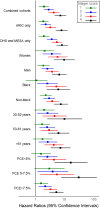Combining Biomarkers and Imaging for Short-Term Assessment of Cardiovascular Disease Risk in Apparently Healthy Adults
- PMID: 32698652
- PMCID: PMC7792258
- DOI: 10.1161/JAHA.119.015410
Combining Biomarkers and Imaging for Short-Term Assessment of Cardiovascular Disease Risk in Apparently Healthy Adults
Abstract
Background Current strategies for cardiovascular disease (CVD) risk assessment focus on 10-year or longer timeframes. Shorter-term CVD risk is also clinically relevant, particularly for high-risk occupations, but is under-investigated. Methods and Results We pooled data from participants in the ARIC (Atherosclerosis Risk in Communities study), MESA (Multi-Ethnic Study of Atherosclerosis), and DHS (Dallas Heart Study), free from CVD at baseline (N=16 581). Measurements included N-terminal pro-B-type natriuretic peptide (>100 pg/mL prospectively defined as abnormal); high-sensitivity cardiac troponin T (abnormal >5 ng/L); high-sensitivity C-reactive protein (abnormal >3 mg/L); left ventricular hypertrophy by ECG (abnormal if present); carotid intima-media thickness, and plaque (abnormal >75th percentile for age and sex or presence of plaque); and coronary artery calcium (abnormal >10 Agatston U). Each abnormal test result except left ventricular hypertrophy by ECG was independently associated with increased 3-year risk of global CVD (myocardial infarction, stroke, coronary revascularization, incident heart failure, or atrial fibrillation), even after adjustment for traditional CVD risk factors and the other test results. When a simple integer score counting the number of abnormal tests was used, 3-year multivariable-adjusted global CVD risk was increased among participants with integer scores of 1, 2, 3, and 4, by ≈2-, 3-, 4.5- and 8-fold, respectively, when compared with those with a score of 0. Qualitatively similar results were obtained for atherosclerotic CVD (fatal or non-fatal myocardial infarction or stroke). Conclusions A strategy incorporating multiple biomarkers and atherosclerosis imaging improved assessment of 3-year global and atherosclerotic CVD risk compared with a standard approach using traditional risk factors.
Keywords: N‐terminal pro B‐type natriuretic peptide; carotid intima‐media thickness; coronary artery calcium; high‐sensitivity C‐reactive protein; high‐sensitivity cardiac troponin T; plaque.
Figures



Comment in
-
Combining Biomarkers and Imaging for Short-Term Assessment of Cardiovascular Disease Risk in Apparently Healthy Adults: A Paradigm-Shifting Approach?J Am Heart Assoc. 2020 Aug 4;9(15):e017790. doi: 10.1161/JAHA.120.017790. Epub 2020 Jul 23. J Am Heart Assoc. 2020. PMID: 32698709 Free PMC article. No abstract available.
References
-
- Goff DC Jr, Lloyd‐Jones DM, Bennett G, Coady S, D'Agostino RB, Gibbons R, Greenland P, Lackland DT, Levy D, O'Donnell CJ, et al. 2013 ACC/AHA guideline on the assessment of cardiovascular risk: a report of the American College of Cardiology/American Heart Association Task Force on Practice Guidelines. Circulation. 2014;129:S49–S73. - PubMed
-
- Grundy SM, Stone NJ, Bailey AL, Beam C, Birtcher KK, Blumenthal RS, Braun LT, de Ferranti S, Faiella‐Tommasino J, Forman DE, et al. 2018 AHA/ACC/AACVPR/AAPA/ABC/ACPM/ADA/AGS/APhA/ASPC/NLA/PCNA guideline on the management of blood cholesterol. Circulation. 2018;139:e1182–e1186.
-
- Whelton PK, Carey RM, Aronow WS, Casey DE Jr, Collins KJ, Dennison Himmelfarb C, DePalma SM, Gidding S, Jamerson KA, Jones DW, et al. 2017 ACC/AHA/AAPA/ABC/ACPM/AGS/APhA/ASH/ASPC/NMA/PCNA guideline for the prevention, detection, evaluation, and management of high blood pressure in adults: a report of the American College of Cardiology/American Heart Association Task Force on Clinical Practice Guidelines. Circulation. 2018;138:e484–e594. - PubMed
-
- Freeman JV, Wang Y, Akar J, Desai N, Krumholz H. National trends in atrial fibrillation hospitalization, readmission, and mortality for Medicare beneficiaries, 1999–2013. Circulation. 2017;135:1227–1239. - PubMed
-
- Hall MJ, Levant S, DeFrances CJ. Hospitalization for Congestive Heart Failure: United States, 2000–2010. NCHS Data Brief. 2012;108:1–8. Hyattsville, MD: National Center for Health Statistics. - PubMed
Publication types
MeSH terms
Substances
Grants and funding
- N01 HC095168/HC/NHLBI NIH HHS/United States
- N01 HC095162/HC/NHLBI NIH HHS/United States
- UL1 TR001420/TR/NCATS NIH HHS/United States
- N01 HC095165/HC/NHLBI NIH HHS/United States
- N01 HC095169/HC/NHLBI NIH HHS/United States
- HHSN268201700002I/HL/NHLBI NIH HHS/United States
- HHSN268201700003I/HL/NHLBI NIH HHS/United States
- HHSN268201500003I/HL/NHLBI NIH HHS/United States
- UL1 TR000040/TR/NCATS NIH HHS/United States
- N01 HC095164/HC/NHLBI NIH HHS/United States
- N01 HC095160/HC/NHLBI NIH HHS/United States
- K23 HL131939/HL/NHLBI NIH HHS/United States
- N01 HC095163/HC/NHLBI NIH HHS/United States
- HHSN268201500003C/HL/NHLBI NIH HHS/United States
- R01 HL071739/HL/NHLBI NIH HHS/United States
- UL1 TR001105/TR/NCATS NIH HHS/United States
- K24 HL152440/HL/NHLBI NIH HHS/United States
- R01 DK089174/DK/NIDDK NIH HHS/United States
- HHSN268201700001I/HL/NHLBI NIH HHS/United States
- N01 HC095159/HC/NHLBI NIH HHS/United States
- HHSN268201700004I/HL/NHLBI NIH HHS/United States
- N01 HC095161/HC/NHLBI NIH HHS/United States
- HHSN268201700005I/HL/NHLBI NIH HHS/United States
- P01 HL137630/HL/NHLBI NIH HHS/United States
- N01 HC095166/HC/NHLBI NIH HHS/United States
- UL1 TR001079/TR/NCATS NIH HHS/United States
- HHSN268201700004C/HL/NHLBI NIH HHS/United States
- N01 HC095167/HC/NHLBI NIH HHS/United States
- R01 HL134320/HL/NHLBI NIH HHS/United States
LinkOut - more resources
Full Text Sources
Research Materials
Miscellaneous

